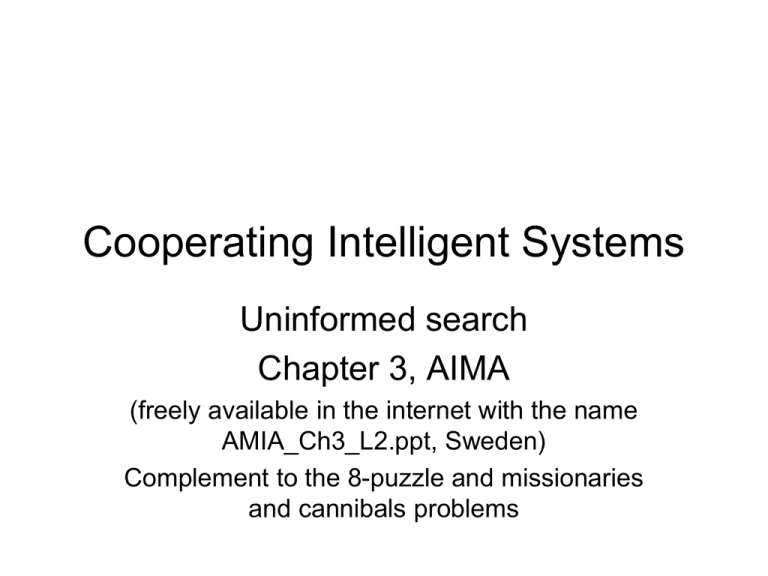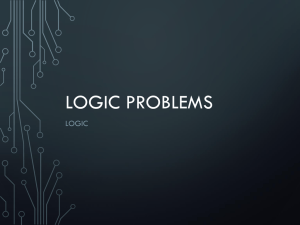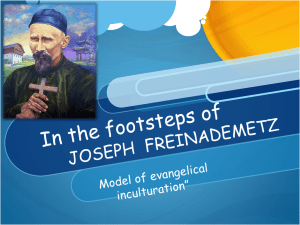State
advertisement

Cooperating Intelligent Systems
Uninformed search
Chapter 3, AIMA
(freely available in the internet with the name
AMIA_Ch3_L2.ppt, Sweden)
Complement to the 8-puzzle and missionaries
and cannibals problems
A ”problem” consists of
•
•
•
•
An initial state, q(0)
A list of possible actions, a, for the agent
A goal test (there can be many goal states)
A path cost
One way to solve this is to search for a path
q(0) q(1) q(2) ... q(N)
such that q(N) is a goal state.
Example: 8-puzzle
• State: Specification of each of
the eight tiles in the nine
squares (the blank is in the
remaining square).
• Initial state: Any state.
• Successor function
(actions): Blank moves Left,
Right, Up, or Down.
2
8
3
1
1
6
4
8
5
7
7
Start State
2
3
4
6
Goal State
5
• Goal test: Check whether the
goal state has been reached.
• Path cost: Each move costs 1.
The path cost = the number of
moves.
Example: 8-puzzle
• State: Specification of each of
the eight tiles in the nine
squares (the blank is in the
remaining square).
• Initial state: Any state.
Examples:
• Successor function
(actions): Blank moves Left,
q = Right,
{7, 2, 4,Up,
5, 0,
8, 3, 1}
or6,Down.
2
8
3
1
1
6
4
8
5
7
7
Start State
2
3
4
6
Goal State
5
• = Goal
test:
the
q
{2, 8, 3,
1, 6,Check
4, 7, 0,whether
5}
goal state has been reached.
• Path cost: Each move costs 1.
The path cost = the number of
moves.
Example: 8-puzzle
• State: Specification of each of
the eight tiles in the nine
squares (the blank is in the
remaining square).
• Initial state: Any state.
• Successor function
(actions): Blank moves Left,
Right, Up, or Down.
2
8
3
1
1
6
4
8
5
7
7
Start State
2
3
4
6
Goal State
5
• Goal test: Check whether the
goal state has been reached.
• Path cost: Each move costs 1.
The path cost = the number of
moves.
Expanding 8-puzzle
2
8
3
1
6
4
7
q = {2, 8, 3, 1, 6, 4, 7, 0, 5}
5
Blank moves right
Blank moves left
Blank moves up
2
8
3
2
1
6
4
1
7
5
7
8
6
3
2
8
3
4
1
6
4
5
7
5
q = {2, 8, 3, 1, 6, 4, 0, 7, 5}
q = {2, 8, 3, 1, 6, 4, 7, 5, 0}
q = {2, 8, 3, 1, 0, 4, 7, 6, 5}
Uninformed search
Searching for the goal without knowing in which direction it
is.
– Breadth-first
– Depth-first
– Iterative deepening
(Depth and breadth refers to the search tree)
We evaluate the algorithms by their:
– Completeness (do they explore all possibilities)
– Optimality (do they find the solution with minimum path cost)
– Time complexity (number of nodes expanded during search)
– Space complexity (maximum number of nodes in memory)
Breadth-first
Image from Russel & Norvig, AIMA, 2003
Nodes marked with open circles = fringe = in the memory
•
•
Breadth-first finds the solution that is closest (in the graph) to the start
node (always expands the shallowest node).
Keeps O(bd) nodes in memory exponential memory requirement!
•
•
•
•
Complete (finds a solution if there is one)
Not necessarily optimal (optimal if cost is the same for each step)
Exponential space complexity (very bad)
Exponential time complexity
b = branching factor, d = depth
Image from N. J. Nilsson, Artificial Intelligence – A New Synthesis, 1998
Breadth-first search for 8puzzle.
The path marked by bold
arrows is the solution.
Note: This assumes that
you apply goal test
immediately after
expansion
(not the case for AIMA
implementation)
If we keep track of visited
states Graph search
(rather than tree search)
Solution in node # 46
Depth-first
Image from Russel & Norvig, AIMA, 2003
•
•
Keeps O(bd) nodes in memory.
Requires a depth limit to avoid
infinite paths
(limit is 3 in the figure).
•
Incomplete (is not guaranteed to
find a solution)
Not optimal
Linear space complexity (good)
Exponential time complexity
•
•
•
Black nodes are removed from memory
b = branching factor, d = depth
Image from N. J. Nilsson, Artificial Intelligence – A New Synthesis, 1998
Depth-first on the 8-puzzle
example.
Depth = 5
Solution in node # 31
Iterative deepening
Image from Russel & Norvig, AIMA, 2003
•
•
•
•
•
•
•
Black nodes are removed from memory
Keeps O(bd) nodes in
memory.
Iteratively increases the depth
limit.
Complete (like BFS)
Not optimal
Linear space complexity
(like DFS)
Exponential time complexity
The preferred search method
for large search spaces with
unknown depth.
b = branching factor, d = depth
Exercise
Exercise 3.4: Show that the 8-puzzle states
are divided into two disjoint sets, such that
no state in one set can be transformed into
a state in the other set by any number of
moves. Devise a procedure that will tell
you which class a given state is in, and
explain why this is a good thing to have for
generating random states.
Proof for exercise 3.4:
Definition: Define the order of
counting from the upper left corner
to the lower right corner (see
figure).
2
8
3
1
6
4
7
5
Let N denote the number of lower
numbers following a number (socalled ”inversions”) when counting
in this fashion.
2
8
3
1
6
4
N = 11 in the figure.
7
2
8
3
2
8
3
2
8
3
2
8
3
2
8
3
1
6
4
1
6
4
1
6
4
1
6
4
1
6
4
5
7
5
7
5
7
5
7
7
1
+
6
+
1
+
2
+
5
1
5
Yellow tiles are inverted
relative to the tile with
”8” in the top row.
= 11
Proof for exercise 3.4:
Proposition: N is either always even or odd
(i.e. Nmod2 is conserved).
Proof:
(1) Sliding the blank along a row does not change the row
number and not the internal order of the tiles, i.e. N (and
thus also Nmod2) is conserved.
(2) Sliding the blank between rows does not change
Nmod2 either, as shown on the following slide.
Proof for exercise 3.4:
We only need to consider tiles B, C, and D since
the relative order of the other tiles remains the
same.
• If B > C and B > D, then the move removes
two inversions.
• If B > C and B < D, then the move adds one
inversion and removes one (sum = 0).
• If B < C and B < D, then the move adds two
inversions.
The number of inversions changes in steps of 2.
A
B
D
F
C
E
G
A
H
C
D
B
E
F
G
H
Observation
The upper state has N = 0
The lower (goal) state has N = 7
1
2
3
4
5
6
7
8
1
2
8
We cannot go from one to the other.
7
3
4
6
5
Exercise
Exercise 3.9: The missionaries and cannibals: Three missionaries and three cannibals are on one
side of a river, along with a boat that can hold one or two people (one for rowing). Find a way to
get everyone to the other side, without ever leaving a group of missionaries in one place
outnumbered by the cannibals in that place (the cannibals eat the missionaries then).
a.
b.
c.
Formulate the problem precisely, making only those distinctions necessary to ensure a valid
solution. Draw a diagram of the complete state space.
Implement and solve the problem optimally using an appropriate search algorithm. Is it a good
idea to check for repeated states?
Why do you think people have a hard time solving this puzzle, given that the state space is so
simple?
Image from http://www.cse.msu.edu/~michmer3/440/Lab1/cannibal.html
Missionaries & Cannibals
State: q = (M,C,B) signifying the number of missionaries, cannibals, and boats on the left
bank. The start state is (3,3,1) and the goal state is (0,0,0).
Actions (successor function): (10 possible but only 5 available each move due to boat)
•
One cannibal/missionary crossing L R: subtract (0,1,1) or (1,0,1)
•
Two cannibals/missionaries crossing L R: subtract (0,2,1) or (2,0,1)
•
One cannibal/missionary crossing R L: add (1,0,1) or (0,1,1)
•
Two cannibals/missionaries crossing R L: add (2,0,1) or (0,2,1)
•
One cannibal and one missionary crossing: add/subtract (1,1,1)
Image from http://www.cse.msu.edu/~michmer3/440/Lab1/cannibal.html
Missionaries & Cannibals states
Assumes that passengers have to get out of the boat after the trip.
Red states = missionaries get eaten.
Breadth-first search on
Missionaries & Cannibals
States are generated by applying:
+/- (1,0,1)
+/- (0,1,1)
+/- (2,0,1)
+/- (0,2,1)
+/- (1,1,1)
In that order (left to right)
Red states = missionaries get eaten
Yellow states = repeated states
Breadth-first search on
Missionaries & Cannibals
States are generated by applying:
+/- (1,0,1)
+/- (0,1,1)
+/- (2,0,1)
+/- (0,2,1)
+/- (1,1,1)
In that order (left to right)
Red states = missionaries get eaten
Yellow states = repeated states
Breadth-first search on
Missionaries & Cannibals
States are generated by applying:
+/- (1,0,1)
+/- (0,1,1)
+/- (2,0,1)
+/- (0,2,1)
+/- (1,1,1)
In that order (left to right)
Red states = missionaries get eaten
Yellow states = repeated states
Breadth-first search on
Missionaries & Cannibals
States are generated by applying:
+/- (1,0,1)
+/- (0,1,1)
+/- (2,0,1)
+/- (0,2,1)
+/- (1,1,1)
In that order (left to right)
Red states = missionaries get eaten
Yellow states = repeated states
Breadth-first search on
Missionaries & Cannibals
States are generated by applying:
+/- (1,0,1)
+/- (0,1,1)
+/- (2,0,1)
+/- (0,2,1)
+/- (1,1,1)
In that order (left to right)
Red states = missionaries get eaten
Yellow states = repeated states
Breadth-first search on
Missionaries & Cannibals
States are generated by applying:
+/- (1,0,1)
+/- (0,1,1)
+/- (2,0,1)
+/- (0,2,1)
+/- (1,1,1)
In that order (left to right)
Red states = missionaries get eaten
Yellow states = repeated states
Breadth-first search on
Missionaries & Cannibals
States are generated by applying:
+/- (1,0,1)
+/- (0,1,1)
+/- (2,0,1)
+/- (0,2,1)
+/- (1,1,1)
In that order (left to right)
Red states = missionaries get eaten
Yellow states = repeated states
Breadth-first search on
Missionaries & Cannibals
States are generated by applying:
+/- (1,0,1)
+/- (0,1,1)
+/- (2,0,1)
+/- (0,2,1)
+/- (1,1,1)
In that order (left to right)
Red states = missionaries get eaten
Yellow states = repeated states
Breadth-first search on
Missionaries & Cannibals
States are generated by applying:
+/- (1,0,1)
+/- (0,1,1)
+/- (2,0,1)
+/- (0,2,1)
+/- (1,1,1)
In that order (left to right)
Red states = missionaries get eaten
Yellow states = repeated states
Breadth-first search on
Missionaries & Cannibals
States are generated by applying:
+/- (1,0,1)
+/- (0,1,1)
+/- (2,0,1)
+/- (0,2,1)
+/- (1,1,1)
In that order (left to right)
Red states = missionaries get eaten
Yellow states = repeated states
Breadth-first search on
Missionaries & Cannibals
States are generated by applying:
+/- (1,0,1)
+/- (0,1,1)
+/- (2,0,1)
+/- (0,2,1)
+/- (1,1,1)
In that order (left to right)
Red states = missionaries get eaten
Yellow states = repeated states
Breadth-first search on
Missionaries & Cannibals
States are generated by applying:
+/- (1,0,1)
+/- (0,1,1)
+/- (2,0,1)
+/- (0,2,1)
+/- (1,1,1)
In that order (left to right)
Red states = missionaries get eaten
Yellow states = repeated states
Breadth-first search on
Missionaries & Cannibals
-(0,2,1)
+(0,1,1)
-(0,2,1)
+(0,1,1)
-(2,0,1)
+(1,1,1)
-(2,0,1)
+(0,1,1)
-(0,2,1)
+(1,0,1)
-(1,1,1)
[2 cannibals cross L R]
[1 cannibal crosses R L]
[2 cannibals cross L R]
[1 cannibal crosses R L]
[2 missionaries cross L R]
[1 cannibal & 1 missionary
cross R L]
[2 missionaries cross L R]
[1 cannibal crosses R L]
[2 cannibals cross L R]
[1 missionary crosses R L]
[1 cannibal & 1 missionary
cross L R]
This is an optimal solution (minimum
number of crossings). [Why?]
Would Depth-first work?
Breadth-first search on
Missionaries & Cannibals
-(0,2,1)
+(0,1,1)
-(0,2,1)
+(0,1,1)
-(2,0,1)
+(1,1,1)
-(2,0,1)
+(0,1,1)
-(0,2,1)
+(1,0,1)
-(1,1,1)
[2 cannibals cross L R]
[1 cannibal crosses R L]
[2 cannibals cross L R]
[1 cannibal crosses R L]
[2 missionaries cross L R]
[1 cannibal & 1 missionary
cross R L]
[2 missionaries cross L R]
[1 cannibal crosses R L]
[2 cannibals cross L R]
[1 missionary crosses R L]
[1 cannibal & 1 missionary
cross L R]
This is an optimal solution (minimum
number of crossings).
Would Depth-first work?
Breadth-first search on
Missionaries & Cannibals
Expanded 48 nodes
Depth-first search on
Missionaries & Cannibals
Expanded 30 nodes
(if repeated states are
checked, otherwise we end
up in an endless loop)









